Setting Up Object to Draw:
As discussed in class, the assignment requirements is to draw one white object or one off white object. Also discussed in class the object should be set up with a light to create light and shadow.Selecting an Object:
Allow for time to choose the appropriate objects. Select objects that will allow for a clear and large areas of shadows to be present. If the shadows progress from light to dark that will be even better. Picking an object that presents interesting shadows and highlights is imperative to meet the objectives. Often the shadow can present an interesting formal and or thematic element in the drawing. If your object can also be thematic and not cliche while still addressing the objectives that will be a bonus.
Information Regarding Objects and Lights for class:
Below are examples of a group of objects (still-life) and a light used for black and white drawing assignments for in class assignments or for home work. This selection of object(s) should not be made at last minute and should have serious contemplations as to which type of object you choose to use. Certain objects will work best in certain contexts and others may not.
The choice of object and level of seriousness in choosing an object will influence the success and ultimately the evaluation (grade) of any given assignment.
Some places to consider obtaining objects may include Value Village, other second hand stores, or garage sales
 The
above white object is a very challenging object due to numerous small
details. A person with experience and extra patience will be required to
successfully draw and to strategically describe light and shadow on the
small details of the object's plastic feathers. Despite the ambitious
choice of an object this work is slightly unfinished, spatially
confused, elliptical shapes are distorted, and some areas of the object
appear flat but overall it is a good drawing.
The
above white object is a very challenging object due to numerous small
details. A person with experience and extra patience will be required to
successfully draw and to strategically describe light and shadow on the
small details of the object's plastic feathers. Despite the ambitious
choice of an object this work is slightly unfinished, spatially
confused, elliptical shapes are distorted, and some areas of the object
appear flat but overall it is a good drawing.
Other Examples of Student Work
Below are some more student examples of work from 1st year drawing courses at the School of Art. The examples below offers ideas in terms of objects that may be used and include graphite as the medium to complete the drawing. Other examples below include the use of charcoal and chalk as well as black and white cote. There is also an example where a student has used a black paper and white chalk and conte as the main drawing tools. Some examples present objects that are transparent, reflective or textured but offer examples for other ideas that are required when depicting objects in other assignments. The above example presents a work that depicts a transparent, reflective objects. For the most part texture is represented on the base that the objects are placed on.
The above example presents a work that depicts a transparent, reflective objects. For the most part texture is represented on the base that the objects are placed on.
 The above example presents a work that depicts a transparent, reflective and textured object.
The above example presents a work that depicts a transparent, reflective and textured object.
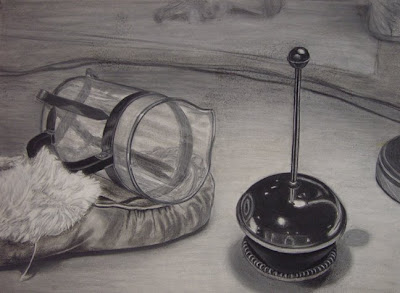 The above example presents an exceptional work that depicts a transparent, reflective and textured object. The composition is very interesting and overall utilizes a combination of mixing white and black to achieve a grayscale as well as utilizing the white of the paper.
The above example presents an exceptional work that depicts a transparent, reflective and textured object. The composition is very interesting and overall utilizes a combination of mixing white and black to achieve a grayscale as well as utilizing the white of the paper.
 Detail of textured and transparent objects in previous drawing.
Detail of textured and transparent objects in previous drawing.
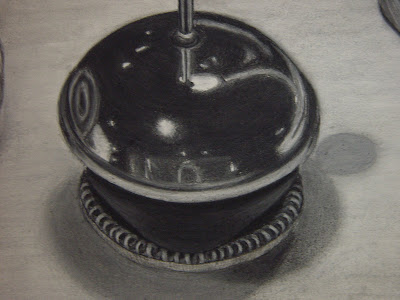 Detail of a reflective object in previous drawing.
Detail of a reflective object in previous drawing.
 The drawing above uses white drawing mediums on black paper to depict an excellent level of transparency and texture in objects.
The drawing above uses white drawing mediums on black paper to depict an excellent level of transparency and texture in objects.
 The above example presents a very good depiction of reflective and transparent objects. As well the objects are given a context that suggest thematic content with the anticipation of the knife cutting into the vegetable. This work at a basic level begins to convey possible symbolic or metaphorical content.
The above example presents a very good depiction of reflective and transparent objects. As well the objects are given a context that suggest thematic content with the anticipation of the knife cutting into the vegetable. This work at a basic level begins to convey possible symbolic or metaphorical content.
Grayscale: 
The above is an example of a 16 step digital grayscale. All rendered black and white drawings are required to utilize the grayscale for each black and white material used in the course.
The grayscale in a drawing is achieved by layering a black medium and allowing different levels of the white of the paper to come through in a drawing, OR a grayscale is achieved by mixing black and white mediums to achieve the range presented in the above grayscale. Often drawings use a combination of both methods (utilizing the white of the paper AND mixing the white with black drawing mediums together)
Creating your own grayscale for each drawing medium will assist in learning about each drawing materials characteristics, plus will allow you to practice depicting and to be more sensitized to the full range of grays in a drawing. Once each grayscale is completed it can be used to compare grayscale levels in a drawing ultimately assisting in the overall success of any given drawing.
Value, Tints and Shades:

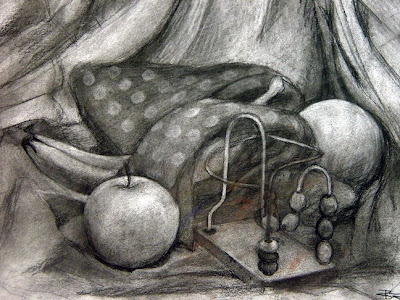 The drawings above demonstrates a depiction of value. Colour has been translated into grayscale. During most of the rendering assignments the objective will be to ignore translating colour and instead will focus on light and shadow and at times will depict surface qualities of texture, reflection and transparency.
The drawings above demonstrates a depiction of value. Colour has been translated into grayscale. During most of the rendering assignments the objective will be to ignore translating colour and instead will focus on light and shadow and at times will depict surface qualities of texture, reflection and transparency.
Reflective Surface:
 The above drawing demonstrates an exceptional depiction of an object with a reflective surface that has very difficult proportions to draw. For the most part there is very good strategic use of detail, edges (soft to sharp) and a good range of contrast and grayscale. Perhaps cropping the object has created some slight spatial confusion (often when a form is cropped at the picture's border it will optically move towards the viewer) but over all this work is an excellent example of a reflective object.
The above drawing demonstrates an exceptional depiction of an object with a reflective surface that has very difficult proportions to draw. For the most part there is very good strategic use of detail, edges (soft to sharp) and a good range of contrast and grayscale. Perhaps cropping the object has created some slight spatial confusion (often when a form is cropped at the picture's border it will optically move towards the viewer) but over all this work is an excellent example of a reflective object.
Strategic use of contrast and levels of detail (work in progress)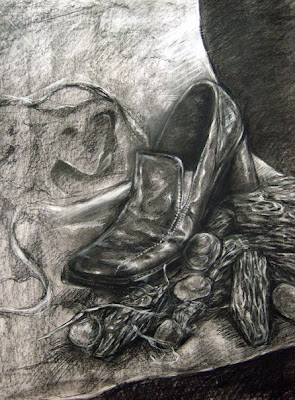
PAINTING Objects with Acrylic
Like in the Negative Space Drawing students are required to mix a black (or a neutral colour which will be close to black) using either Raw Umber with Phthalo Blue OR Alizarin Crimson Red with Pthalo Green. Like in the previous rendered assignments the objectives for rendered drawing assignments will be required with the addition of mixing the grayscale or monochromatic range (using white with the mixed black) and considering the range of mark making with various brush sizes.
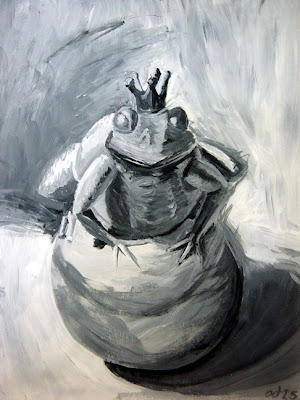 Another good example of a white object but completed with acrylic
paint. The strategy of this work follows much of the strategy used in
the above drawings.
Another good example of a white object but completed with acrylic
paint. The strategy of this work follows much of the strategy used in
the above drawings.
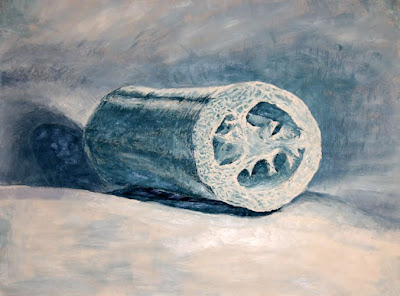 The
above example presents an exceptional depiction of a textured object
using paint. Part of the success of this drawing was due to the intense
layering of paint and editing with the paint. This work demonstrates a
combination of the paint being used in a thick and opaque ways with
multiple transparent layers (glazing technique) where layered washes of
paint are applied often with several layers. In some select areas
glazing was used on thick areas of paint (once the the thick areas were
dry) to either decrease or increase contrast. As well this work
represents an overall excellent example of strategic use with detail,
contrast and sharp to soft edges.
The
above example presents an exceptional depiction of a textured object
using paint. Part of the success of this drawing was due to the intense
layering of paint and editing with the paint. This work demonstrates a
combination of the paint being used in a thick and opaque ways with
multiple transparent layers (glazing technique) where layered washes of
paint are applied often with several layers. In some select areas
glazing was used on thick areas of paint (once the the thick areas were
dry) to either decrease or increase contrast. As well this work
represents an overall excellent example of strategic use with detail,
contrast and sharp to soft edges.
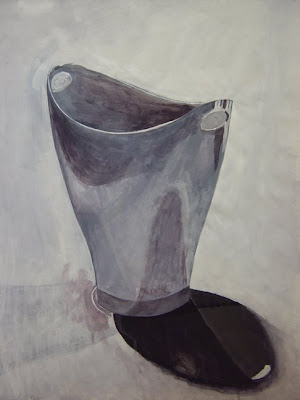 Another white object depicted with acrylic paint. The process of this
painting was done with a glazing technique that is similarly used in
watercolour. The acrylic paint is watered down and multiple layers of
translucent tints are used as part of the technique to build up the 3
dimensional illusion in the work. Note: this work did not use black-
instead alizarin crimson (red) and pthalo green were used to create
black.
Another white object depicted with acrylic paint. The process of this
painting was done with a glazing technique that is similarly used in
watercolour. The acrylic paint is watered down and multiple layers of
translucent tints are used as part of the technique to build up the 3
dimensional illusion in the work. Note: this work did not use black-
instead alizarin crimson (red) and pthalo green were used to create
black.
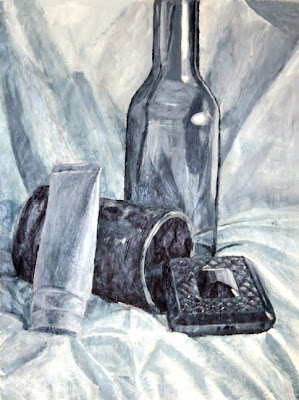 An ambitious example of a textured, reflective and transparent objects
used in a painted still life. Spatially the depiction of the objects
are slightly confused and perhaps more strategic use of detail, contrast
and sharp to soft edges should have been considered but in combination
overall a very good and ambitious painting of textured, reflective and transparent surfaces.
An ambitious example of a textured, reflective and transparent objects
used in a painted still life. Spatially the depiction of the objects
are slightly confused and perhaps more strategic use of detail, contrast
and sharp to soft edges should have been considered but in combination
overall a very good and ambitious painting of textured, reflective and transparent surfaces.
Black & White Dry Drawing Mediums Continued:
 The
above white object's success is derived from the strategic use of soft
and hard edges, articulation of detail (or lack of detail) and
different levels of high and low contrast. The doll's limbs on its left
side are drawn with a very different approach (drawing style) than the
limbs on the right side.
The
above white object's success is derived from the strategic use of soft
and hard edges, articulation of detail (or lack of detail) and
different levels of high and low contrast. The doll's limbs on its left
side are drawn with a very different approach (drawing style) than the
limbs on the right side.




 The drawing above demonstrates a depiction of value. Colour has been translated into grayscale.
The drawing above demonstrates a depiction of value. Colour has been translated into grayscale.
 The drawing above and the two drawings below make use of black, coloured, or a tinted paper.
The drawing above and the two drawings below make use of black, coloured, or a tinted paper.
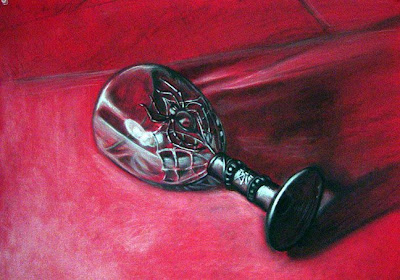
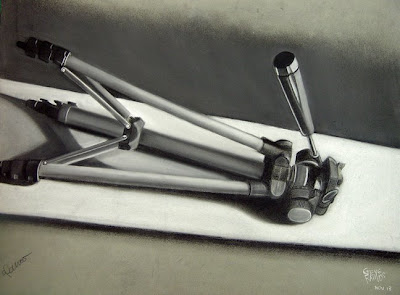
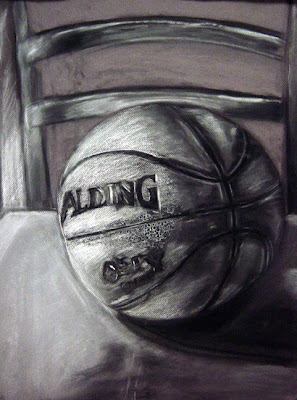
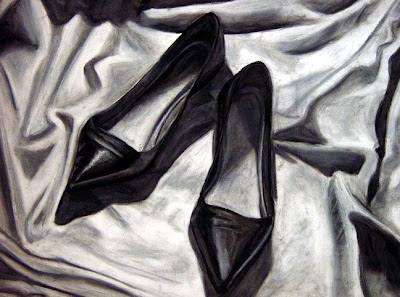
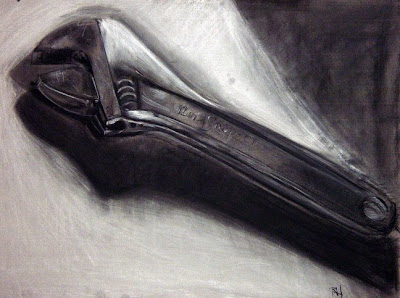


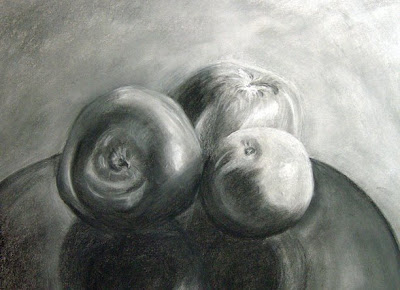
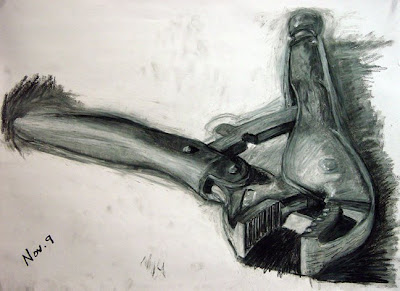
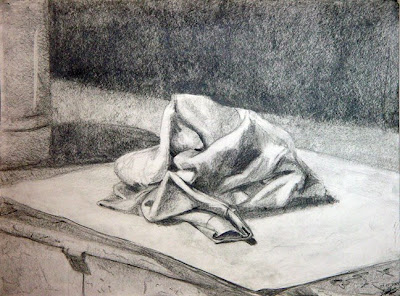 In
this example of work above the chosen object of an arranged cloth was
clearly chosen at last minute and appears to be drawn slightly flat and
the spatial relationships within the cloth are slightly confused. As
well some line could have been absorbed more into the rendered shadow
areas. However the composition is excellent due to various subject
matter in the back ground and foreground and the way forms are
interacting with the border edges of the drawing. As well there is an
excellent use of atmospheric perspective created by the strategic use of
various soft and sharp edges progressing from the background to
foreground. As well the strategic use in different levels of detail, and
different levels of contrast also assist in the overall success of this
drawing's and its illusion of volumes in space.
In
this example of work above the chosen object of an arranged cloth was
clearly chosen at last minute and appears to be drawn slightly flat and
the spatial relationships within the cloth are slightly confused. As
well some line could have been absorbed more into the rendered shadow
areas. However the composition is excellent due to various subject
matter in the back ground and foreground and the way forms are
interacting with the border edges of the drawing. As well there is an
excellent use of atmospheric perspective created by the strategic use of
various soft and sharp edges progressing from the background to
foreground. As well the strategic use in different levels of detail, and
different levels of contrast also assist in the overall success of this
drawing's and its illusion of volumes in space.
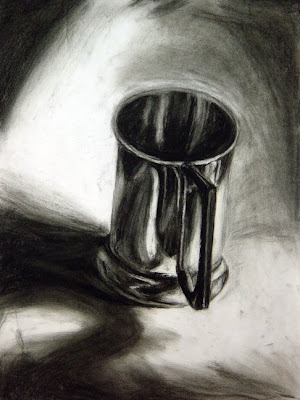

Allow for time to choose the appropriate objects. Select objects that will allow for a clear and large areas of shadows to be present. If the shadows progress from light to dark that will be even better. Picking an object that presents interesting shadows and highlights is imperative to meet the objectives. Often the shadow can present an interesting formal and or thematic element in the drawing. If your object can also be thematic and not cliche while still addressing the objectives that will be a bonus.
Formal Characteristics in Drawing and Progression of Space:
* For any assignments regarding black and white rendering (shading) the strategic use in a full range of soft and hard edges, full range of grayscales, full range of mark making, full range of detail progressing to lack of detail and different levels of high and low contrast will be required. This will help to depict and clear progression of space. As well this expand a person's drawing style.
Composition:
For these assignments it is also required to have a composition of subject matter that is unique and interesting but also integrates all the required assignment objectives in the work.
Thematic Content:
This object should have or be set up in a way to have potential thematic content. As an option anthropomorphic characteristics inherent in an object or created by a certain viewpoint or lighting can also offer thematic content.
Drawing Process:
Initial drawing process should lightly depict basic shapes of shadow and light first. Shapes should also initially be out of focus (soft edges).
Formal Characteristics:
Eventually via a layering process the object should be strategically depicted in terms of ranges of detail, contrast and edges in relation to the progression of space. *
Strategic use of contrast, levels of detail and variations of soft and sharp edges in single object:
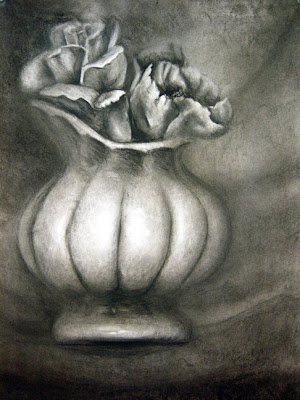
 Create your own grayscale with your drawing materials specific to each assignment requirements when analyzing your white object drawing to ensure you have a range of tones when depicting the object(s)
Create your own grayscale with your drawing materials specific to each assignment requirements when analyzing your white object drawing to ensure you have a range of tones when depicting the object(s)
Mass Volumes & Space (10%): Clear depiction in the illusion of 3 dimensional masses in space that progresses in a clear manner from foreground to background. Over lapping of forms and strategic use of detail, contrast, range of edges, grayscales, angles and composition will all be crucial in achieving a strong illusion of 3 dimensional mass and depth of space. In many ways this final point criteria is about synthesizing all the above formal concepts into a unique and unified work. The examples below focuses on light and shadow with some drawing examples depicting 3 objects simultaneously in a single drawing with surface qualities of texture, reflection and transparency. Many ideas presented in images below can be applied to the single white object. The example below also present various examples of black and white media used.
Light source such as a clip on lamp will be very useful for the success of the project.
 Interior Design Student Work
Interior Design Student Work
The above graphite drawing demonstrates a refined rendering style that offers a strategic use of detail and high contrast in the foreground. As well the drawing progressively decreases in detail and contrast as the viewer reaches the background. As well due primarily to the increased contrast, the edges in the foreground appear sharper, while the edges of forms in the background begin to slightly dissolve. A very good drawing but more absorbing of line, greater range of soft to sharp edges and a clearer depiction of the three surfaces of texture, reflection and transparency is required.
 Interior Design Student Work
Interior Design Student Work
The above graphite drawing demonstrates a strategic use of detail and high contrast in the foreground. As well the drawing progressively decreases in detail and contrast as the viewer reaches the background. As well the edges in the foreground are sharper and the edges of forms in the background are progressively dissolving into the background space. A very good drawing but clearer depiction of reflective and transparent surfaces are required.
* For any assignments regarding black and white rendering (shading) the strategic use in a full range of soft and hard edges, full range of grayscales, full range of mark making, full range of detail progressing to lack of detail and different levels of high and low contrast will be required. This will help to depict and clear progression of space. As well this expand a person's drawing style.
Composition:
For these assignments it is also required to have a composition of subject matter that is unique and interesting but also integrates all the required assignment objectives in the work.
Thematic Content:
This object should have or be set up in a way to have potential thematic content. As an option anthropomorphic characteristics inherent in an object or created by a certain viewpoint or lighting can also offer thematic content.
Drawing Process:
Initial drawing process should lightly depict basic shapes of shadow and light first. Shapes should also initially be out of focus (soft edges).
Formal Characteristics:
Eventually via a layering process the object should be strategically depicted in terms of ranges of detail, contrast and edges in relation to the progression of space. *
Strategic use of contrast, levels of detail and variations of soft and sharp edges in single object:

The above drawing of a white porcelain object is also a good example of a white or an off-white object. With the exception of a vaguely drawn table plane in the foreground area the execution of the drawing fulfills the formal objectives of the assignment. The entire page is filled with various tones and a strong sense of mass (the objects forms) are depicted an atmosphere. Some parts of the above object appear to almost pop out from the page of the paper. This drawing as well demonstrates a strategic use of detail and high contrast in the foreground. As well the drawing progressively decreases in detail and in contrast as the viewer reaches the background and furthest edges of the object. As well the edges in the foreground (center of the object) are sharper and the outer edges of the object progressively dissolving into the background space. Overall this work is an excellent example of strategically depicting soft and sharp edges in relation to space.
Formal Issues in Light and Shadow Rendering /B & W Shading and Tones (for Grading):
Process (10%): Tonal drawing involves layering process that starts tentatively (drawn lightly and rough with soft edges) With this type of drawing in early stages initially map out subject matter into basic shapes of light and shadow (planes & other basic geometric shapes) As in the previous assignments no detail in beginning stages of drawing and start in the center work directly out and around from initial shape. Use initial shape as building block and reference for comparing proportion and choosing composition. Tentatively (and lightly) map out entire composition before committing to: detail, exact locations of shapes, levels of high contrast, thick layering of drawing mediums, and sharp edges. As in previous assignments anticipate editing with a combination of additive and subtractive processes in the drawing. As in previous work anticipate at times a messy process of restating and editing to occur during the layering process. Remember for a rendered drawing the ultimate goal is to absorb all lines into shaded areas.
Accurate Proportion, Scale and Perspective (20%): utilizing measurements, horizontal/vertical alignments and 1pt & 2pt perspective. When working from observation generally use the theories of perspective (vanishing points & horizon line) at later stages of drawing as a tool for checking accuracy of proportions, scale, etc. As in the previous assignments whether working from observation or imagination do not lock into horizon line and vanishing points until proportions are resolved.
Composition (15%): As in previous work locate an interesting view with a reasonable level of difficulty that will have a unique and complex interaction of shapes through out picture (including border of drawing) and choose a composition that is conducive for presenting the objectives for the assignment.
Strategic Levels of Contrast (15%): increasing or decreasing contrast in strategically chosen areas will assist in depicting the illusion of 3 dimensional forms and the illusion of space. Often a subtle progression of decreased contrast (along with hard to soft edges) will need consideration in the final stages of the layering process.
Strategic use of Detail (15%): Anticipate that progressively there will be less detail as the viewer moves back into the space of the picture plane. Various levels of detail will also be required on some single objects or planes located in the foreground and at times in the middleground. This is the final stage of the layering process. Make time to allow for some careful finishing touches and to strategically refine or layer over rougher areas in the work. In some ways this has connections to the ranges of marking in the drawing and layering process.
Range of Tones, Edges and Mark Making (15%): Anticipate strategically using a full range of grayscales (dark to light tones) and range of edges (hard/sharp to soft/out of focus edges) during the entire drawing process. During the early stages of the drawing use only soft (tentative/out of focus) edges and light to middle grayscale tones to tentatively map out entire drawing. As well utilize a full range of mark making from smudged to raw marks, short to long marks, curved to angular marks, and various pressures of gentle touch to pressing heavily on the drawing surface. When investigating mark making, tones and edges keep in mind that your eraser can be a drawing tool as much as any other drawing medium.
Process (10%): Tonal drawing involves layering process that starts tentatively (drawn lightly and rough with soft edges) With this type of drawing in early stages initially map out subject matter into basic shapes of light and shadow (planes & other basic geometric shapes) As in the previous assignments no detail in beginning stages of drawing and start in the center work directly out and around from initial shape. Use initial shape as building block and reference for comparing proportion and choosing composition. Tentatively (and lightly) map out entire composition before committing to: detail, exact locations of shapes, levels of high contrast, thick layering of drawing mediums, and sharp edges. As in previous assignments anticipate editing with a combination of additive and subtractive processes in the drawing. As in previous work anticipate at times a messy process of restating and editing to occur during the layering process. Remember for a rendered drawing the ultimate goal is to absorb all lines into shaded areas.
Accurate Proportion, Scale and Perspective (20%): utilizing measurements, horizontal/vertical alignments and 1pt & 2pt perspective. When working from observation generally use the theories of perspective (vanishing points & horizon line) at later stages of drawing as a tool for checking accuracy of proportions, scale, etc. As in the previous assignments whether working from observation or imagination do not lock into horizon line and vanishing points until proportions are resolved.
Composition (15%): As in previous work locate an interesting view with a reasonable level of difficulty that will have a unique and complex interaction of shapes through out picture (including border of drawing) and choose a composition that is conducive for presenting the objectives for the assignment.
Strategic Levels of Contrast (15%): increasing or decreasing contrast in strategically chosen areas will assist in depicting the illusion of 3 dimensional forms and the illusion of space. Often a subtle progression of decreased contrast (along with hard to soft edges) will need consideration in the final stages of the layering process.
Strategic use of Detail (15%): Anticipate that progressively there will be less detail as the viewer moves back into the space of the picture plane. Various levels of detail will also be required on some single objects or planes located in the foreground and at times in the middleground. This is the final stage of the layering process. Make time to allow for some careful finishing touches and to strategically refine or layer over rougher areas in the work. In some ways this has connections to the ranges of marking in the drawing and layering process.
Range of Tones, Edges and Mark Making (15%): Anticipate strategically using a full range of grayscales (dark to light tones) and range of edges (hard/sharp to soft/out of focus edges) during the entire drawing process. During the early stages of the drawing use only soft (tentative/out of focus) edges and light to middle grayscale tones to tentatively map out entire drawing. As well utilize a full range of mark making from smudged to raw marks, short to long marks, curved to angular marks, and various pressures of gentle touch to pressing heavily on the drawing surface. When investigating mark making, tones and edges keep in mind that your eraser can be a drawing tool as much as any other drawing medium.
 Create your own grayscale with your drawing materials specific to each assignment requirements when analyzing your white object drawing to ensure you have a range of tones when depicting the object(s)
Create your own grayscale with your drawing materials specific to each assignment requirements when analyzing your white object drawing to ensure you have a range of tones when depicting the object(s) Other Examples of White Objects (or off White Objects):
Light source such as a clip on lamp will be very useful for the success of the project.
 Interior Design Student Work
Interior Design Student Work The above graphite drawing demonstrates a refined rendering style that offers a strategic use of detail and high contrast in the foreground. As well the drawing progressively decreases in detail and contrast as the viewer reaches the background. As well due primarily to the increased contrast, the edges in the foreground appear sharper, while the edges of forms in the background begin to slightly dissolve. A very good drawing but more absorbing of line, greater range of soft to sharp edges and a clearer depiction of the three surfaces of texture, reflection and transparency is required.
 Interior Design Student Work
Interior Design Student Work The above graphite drawing demonstrates a strategic use of detail and high contrast in the foreground. As well the drawing progressively decreases in detail and contrast as the viewer reaches the background. As well the edges in the foreground are sharper and the edges of forms in the background are progressively dissolving into the background space. A very good drawing but clearer depiction of reflective and transparent surfaces are required.
Ideas and Process:
Strategic use of contrast and levels of detail
 The
above drawing of garlic clover is unfinished and is not an example of
reflective or transparent surface, but demonstrates some of the key
objectives for drawing objects with light and shadow. The drawing
demonstrates a strategic use of detail and high contrast in the
foreground. As well the drawing progressively decreases in detail and
contrast as the viewer reaches the background (the clover that is
farthest form in the picture) As well the edges in the foreground are
sharper and the edges of the clovers in the background are progressively
dissolving into the background space.
The
above drawing of garlic clover is unfinished and is not an example of
reflective or transparent surface, but demonstrates some of the key
objectives for drawing objects with light and shadow. The drawing
demonstrates a strategic use of detail and high contrast in the
foreground. As well the drawing progressively decreases in detail and
contrast as the viewer reaches the background (the clover that is
farthest form in the picture) As well the edges in the foreground are
sharper and the edges of the clovers in the background are progressively
dissolving into the background space.
The process of the above garlic drawing is also excellent. This process entailed drawing lightly and tentatively over the entire paper and then in the mid to later stages detail and daker tones were layered onto the drawing. The above process can also apply to a single object as well.
Strategic use of contrast and levels of detail
 The
above drawing of garlic clover is unfinished and is not an example of
reflective or transparent surface, but demonstrates some of the key
objectives for drawing objects with light and shadow. The drawing
demonstrates a strategic use of detail and high contrast in the
foreground. As well the drawing progressively decreases in detail and
contrast as the viewer reaches the background (the clover that is
farthest form in the picture) As well the edges in the foreground are
sharper and the edges of the clovers in the background are progressively
dissolving into the background space.
The
above drawing of garlic clover is unfinished and is not an example of
reflective or transparent surface, but demonstrates some of the key
objectives for drawing objects with light and shadow. The drawing
demonstrates a strategic use of detail and high contrast in the
foreground. As well the drawing progressively decreases in detail and
contrast as the viewer reaches the background (the clover that is
farthest form in the picture) As well the edges in the foreground are
sharper and the edges of the clovers in the background are progressively
dissolving into the background space.The process of the above garlic drawing is also excellent. This process entailed drawing lightly and tentatively over the entire paper and then in the mid to later stages detail and daker tones were layered onto the drawing. The above process can also apply to a single object as well.
Information Regarding Objects and Lights for class:
Below are examples of a group of objects (still-life) and a light used for black and white drawing assignments for in class assignments or for home work. This selection of object(s) should not be made at last minute and should have serious contemplations as to which type of object you choose to use. Certain objects will work best in certain contexts and others may not.
The choice of object and level of seriousness in choosing an object will influence the success and ultimately the evaluation (grade) of any given assignment.
Some places to consider obtaining objects may include Value Village, other second hand stores, or garage sales
 The
above white object is a very challenging object due to numerous small
details. A person with experience and extra patience will be required to
successfully draw and to strategically describe light and shadow on the
small details of the object's plastic feathers. Despite the ambitious
choice of an object this work is slightly unfinished, spatially
confused, elliptical shapes are distorted, and some areas of the object
appear flat but overall it is a good drawing.
The
above white object is a very challenging object due to numerous small
details. A person with experience and extra patience will be required to
successfully draw and to strategically describe light and shadow on the
small details of the object's plastic feathers. Despite the ambitious
choice of an object this work is slightly unfinished, spatially
confused, elliptical shapes are distorted, and some areas of the object
appear flat but overall it is a good drawing.Other Examples of Student Work
Below are some more student examples of work from 1st year drawing courses at the School of Art. The examples below offers ideas in terms of objects that may be used and include graphite as the medium to complete the drawing. Other examples below include the use of charcoal and chalk as well as black and white cote. There is also an example where a student has used a black paper and white chalk and conte as the main drawing tools. Some examples present objects that are transparent, reflective or textured but offer examples for other ideas that are required when depicting objects in other assignments.
 The above example presents a work that depicts a transparent, reflective objects. For the most part texture is represented on the base that the objects are placed on.
The above example presents a work that depicts a transparent, reflective objects. For the most part texture is represented on the base that the objects are placed on. The above example presents a work that depicts a transparent, reflective and textured object.
The above example presents a work that depicts a transparent, reflective and textured object. The above example presents an exceptional work that depicts a transparent, reflective and textured object. The composition is very interesting and overall utilizes a combination of mixing white and black to achieve a grayscale as well as utilizing the white of the paper.
The above example presents an exceptional work that depicts a transparent, reflective and textured object. The composition is very interesting and overall utilizes a combination of mixing white and black to achieve a grayscale as well as utilizing the white of the paper. Detail of textured and transparent objects in previous drawing.
Detail of textured and transparent objects in previous drawing. Detail of a reflective object in previous drawing.
Detail of a reflective object in previous drawing. The drawing above uses white drawing mediums on black paper to depict an excellent level of transparency and texture in objects.
The drawing above uses white drawing mediums on black paper to depict an excellent level of transparency and texture in objects. The above example presents a very good depiction of reflective and transparent objects. As well the objects are given a context that suggest thematic content with the anticipation of the knife cutting into the vegetable. This work at a basic level begins to convey possible symbolic or metaphorical content.
The above example presents a very good depiction of reflective and transparent objects. As well the objects are given a context that suggest thematic content with the anticipation of the knife cutting into the vegetable. This work at a basic level begins to convey possible symbolic or metaphorical content.Grayscale:

The above is an example of a 16 step digital grayscale. All rendered black and white drawings are required to utilize the grayscale for each black and white material used in the course.
The grayscale in a drawing is achieved by layering a black medium and allowing different levels of the white of the paper to come through in a drawing, OR a grayscale is achieved by mixing black and white mediums to achieve the range presented in the above grayscale. Often drawings use a combination of both methods (utilizing the white of the paper AND mixing the white with black drawing mediums together)
Creating your own grayscale for each drawing medium will assist in learning about each drawing materials characteristics, plus will allow you to practice depicting and to be more sensitized to the full range of grays in a drawing. Once each grayscale is completed it can be used to compare grayscale levels in a drawing ultimately assisting in the overall success of any given drawing.
Value, Tints and Shades:

 The drawings above demonstrates a depiction of value. Colour has been translated into grayscale. During most of the rendering assignments the objective will be to ignore translating colour and instead will focus on light and shadow and at times will depict surface qualities of texture, reflection and transparency.
The drawings above demonstrates a depiction of value. Colour has been translated into grayscale. During most of the rendering assignments the objective will be to ignore translating colour and instead will focus on light and shadow and at times will depict surface qualities of texture, reflection and transparency.Reflective Surface:
 The above drawing demonstrates an exceptional depiction of an object with a reflective surface that has very difficult proportions to draw. For the most part there is very good strategic use of detail, edges (soft to sharp) and a good range of contrast and grayscale. Perhaps cropping the object has created some slight spatial confusion (often when a form is cropped at the picture's border it will optically move towards the viewer) but over all this work is an excellent example of a reflective object.
The above drawing demonstrates an exceptional depiction of an object with a reflective surface that has very difficult proportions to draw. For the most part there is very good strategic use of detail, edges (soft to sharp) and a good range of contrast and grayscale. Perhaps cropping the object has created some slight spatial confusion (often when a form is cropped at the picture's border it will optically move towards the viewer) but over all this work is an excellent example of a reflective object.Strategic use of contrast and levels of detail (work in progress)

PAINTING Objects with Acrylic
Like in the Negative Space Drawing students are required to mix a black (or a neutral colour which will be close to black) using either Raw Umber with Phthalo Blue OR Alizarin Crimson Red with Pthalo Green. Like in the previous rendered assignments the objectives for rendered drawing assignments will be required with the addition of mixing the grayscale or monochromatic range (using white with the mixed black) and considering the range of mark making with various brush sizes.
 Another good example of a white object but completed with acrylic
paint. The strategy of this work follows much of the strategy used in
the above drawings.
Another good example of a white object but completed with acrylic
paint. The strategy of this work follows much of the strategy used in
the above drawings. The
above example presents an exceptional depiction of a textured object
using paint. Part of the success of this drawing was due to the intense
layering of paint and editing with the paint. This work demonstrates a
combination of the paint being used in a thick and opaque ways with
multiple transparent layers (glazing technique) where layered washes of
paint are applied often with several layers. In some select areas
glazing was used on thick areas of paint (once the the thick areas were
dry) to either decrease or increase contrast. As well this work
represents an overall excellent example of strategic use with detail,
contrast and sharp to soft edges.
The
above example presents an exceptional depiction of a textured object
using paint. Part of the success of this drawing was due to the intense
layering of paint and editing with the paint. This work demonstrates a
combination of the paint being used in a thick and opaque ways with
multiple transparent layers (glazing technique) where layered washes of
paint are applied often with several layers. In some select areas
glazing was used on thick areas of paint (once the the thick areas were
dry) to either decrease or increase contrast. As well this work
represents an overall excellent example of strategic use with detail,
contrast and sharp to soft edges. Another white object depicted with acrylic paint. The process of this
painting was done with a glazing technique that is similarly used in
watercolour. The acrylic paint is watered down and multiple layers of
translucent tints are used as part of the technique to build up the 3
dimensional illusion in the work. Note: this work did not use black-
instead alizarin crimson (red) and pthalo green were used to create
black.
Another white object depicted with acrylic paint. The process of this
painting was done with a glazing technique that is similarly used in
watercolour. The acrylic paint is watered down and multiple layers of
translucent tints are used as part of the technique to build up the 3
dimensional illusion in the work. Note: this work did not use black-
instead alizarin crimson (red) and pthalo green were used to create
black. An ambitious example of a textured, reflective and transparent objects
used in a painted still life. Spatially the depiction of the objects
are slightly confused and perhaps more strategic use of detail, contrast
and sharp to soft edges should have been considered but in combination
overall a very good and ambitious painting of textured, reflective and transparent surfaces.
An ambitious example of a textured, reflective and transparent objects
used in a painted still life. Spatially the depiction of the objects
are slightly confused and perhaps more strategic use of detail, contrast
and sharp to soft edges should have been considered but in combination
overall a very good and ambitious painting of textured, reflective and transparent surfaces.Black & White Dry Drawing Mediums Continued:
 The
above white object's success is derived from the strategic use of soft
and hard edges, articulation of detail (or lack of detail) and
different levels of high and low contrast. The doll's limbs on its left
side are drawn with a very different approach (drawing style) than the
limbs on the right side.
The
above white object's success is derived from the strategic use of soft
and hard edges, articulation of detail (or lack of detail) and
different levels of high and low contrast. The doll's limbs on its left
side are drawn with a very different approach (drawing style) than the
limbs on the right side.



 The drawing above demonstrates a depiction of value. Colour has been translated into grayscale.
The drawing above demonstrates a depiction of value. Colour has been translated into grayscale. The drawing above and the two drawings below make use of black, coloured, or a tinted paper.
The drawing above and the two drawings below make use of black, coloured, or a tinted paper. 








 In
this example of work above the chosen object of an arranged cloth was
clearly chosen at last minute and appears to be drawn slightly flat and
the spatial relationships within the cloth are slightly confused. As
well some line could have been absorbed more into the rendered shadow
areas. However the composition is excellent due to various subject
matter in the back ground and foreground and the way forms are
interacting with the border edges of the drawing. As well there is an
excellent use of atmospheric perspective created by the strategic use of
various soft and sharp edges progressing from the background to
foreground. As well the strategic use in different levels of detail, and
different levels of contrast also assist in the overall success of this
drawing's and its illusion of volumes in space.
In
this example of work above the chosen object of an arranged cloth was
clearly chosen at last minute and appears to be drawn slightly flat and
the spatial relationships within the cloth are slightly confused. As
well some line could have been absorbed more into the rendered shadow
areas. However the composition is excellent due to various subject
matter in the back ground and foreground and the way forms are
interacting with the border edges of the drawing. As well there is an
excellent use of atmospheric perspective created by the strategic use of
various soft and sharp edges progressing from the background to
foreground. As well the strategic use in different levels of detail, and
different levels of contrast also assist in the overall success of this
drawing's and its illusion of volumes in space.









No comments:
Post a Comment